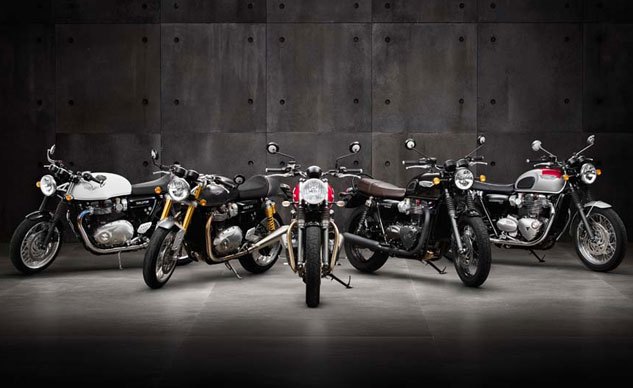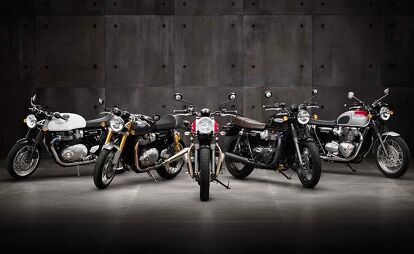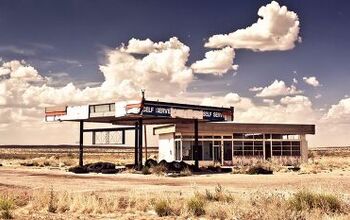Triumph Announces Three New Engine Configurations and Five All-New Models for 2016 Bonneville Line

We check out the 2016 Triumph Street Twin, Bonneville T120 and Thruxton
Suppose you ran a motorcycle manufacturer lucky enough to have produced one of the most iconic motorcycle lines of an era. For the past 15 years your factories had assembled a popular family of motorcycles based on that previous generation to steady increase in sales, ultimately totaling 20% of the company’s international purchases. Still, progress marches onward, global emissions laws change, and the time is ripe for refreshing and broadening the model line. Having stewardship over an icon carries a special weight, making any revision fraught with risk. However, where there is risk, often there is great opportunity nearby. Triumph Motorcycles found itself in just that position with the Bonneville and set about the task of updating and broadening the family to meet today’s motorcycling while remaining true to its heritage.
At a recent gathering of the world moto-press in London, Triumph outlined the design philosophy for its project to evolve the Bonneville icon. Miles Perkins, Head of Brand Management, outlined the delicate standard that the company felt must be met, saying that when transforming an icon, “it shouldn’t be a new, new thing; it should be today’s version of the thing.”
To guide the four years of designing the future of Bonneville, the development team utilized five goals: First, bring out more of the elemental character of the Bonneville. The 15 years of producing the Hinckley-era Bonnies had afforded many opportunities to study what exactly created the essence of the Bonneville and what needed to be changed. Second, make the styling and the fit and finish better. Third, upgrade the Bonneville’s performance and handling on a fundamental level. Fourth, incorporate the capabilities we expect from a modern motorcycle without damaging the character that makes a Bonneville a Bonneville. Finally, design the motorcycle to be customizable. The ability to put a personal touch on a motorcycle – particularly a Modern Classic motorcycle – is as important as its outright ability. The result is a family of motorcycles that completely replaces the previous generation Bonnevilles, with the exception of three holdover models: the Scrambler, the America, and the Speedmaster. The new models are: Street Twin, Bonneville T120 and T120 Black, Thruxton and Thruxton R.
The Beating Heart of the Bonneville
At the Bike Shed Motorcycle Club in the Shoreditch section of London, a location Triumph said is at the heart of the London custom motorcycle scene, a total of five new Bonnevilles were unveiled. These models represent a complete redesign of the Bonneville, sharing no components with the previous generation.
Three different engines were developed for these new motorcycles. To make the manufacturing process as efficient as possible, the engine’s components were built around as many common parts as feasible. While the displacement was bumped from the previous generation’s 865cc to 900cc and 1200cc, the two displacement categories share a basic bottom-end construction, though some differences were necessary to suit the different power output targets. These will be discussed along with the other features of the individual models.
Because the engine silhouette was so important, the designers chose to alter displacement via bore rather than stroke. With the bottom end built to accommodate the wider piston-spacing required for the additional bore diameter, the cylinder jugs look the same regardless of displacement.
“We wanted both engines to look the same so that it fits in the package,” noted Stuart Wood, Chief Engineer of the Bonneville project. ”So that the bike looks right with the engine fitted in its relative position to the other components: the fuel tank, the seat, and all that.” One of the advantages of this approach, Wood continued, was that it allowed designers to “optimize compression ratio correctly rather than having big domes on pistons.”
When it comes to how the engine looks, perhaps no area was as important as the transition to liquid-cooling. The advantages of switching from air-/oil-cooling are obvious from a performance perspective, but tremendous effort was made towards making the radiator not intrude into the visuals. The result is a radiator that, while being larger than the previous oil cooler, carries less visual weight. No hoses hang out in the wind. Instead, they are tucked between the frame downtubes. Even the coolant expansion tank is tucked away in an unlikely place, behind the countershaft cover with the coolant level sight glass on the cover’s leading edge being the only visual clue.
The exhaust headers appear to be a single uninterrupted pipe from manifold to muffler when, through the use of clever covers or dual skins, the gasses are actually directed through a catalyst under the engine. Similarly, where the previous Bonnie used actual carburetor bodies to house the fuel injectors, the 1200 engine’s ride-by-wire hardware is hidden inside throttle bodies that look like carburetors – complete with float bowls and brass screw rings over the top where the slides would reside.
Following the design team’s fourth goal of upgrading the motorcycle’s capabilities to those of a thoroughly modern bike, r-b-w allows for a host of other technologies. All three engines utilize traction control. Additionally, the 1200s feature ride modes that the user can change on the fly from a handlebar mounted switch. Naturally, ABS is included on all of the new Bonnies.
Framing a Classic
As with the engines sharing the same basic design, the 2016 Bonneville line shares the same basic chassis architecture. This largely to maintain the dimensions and profile the designers used to tie the current Bonnies to those of old. Through the suspension and other means, like swingarm length, the chassis performance is fine-tuned to each model’s desired handling characteristics. For example, according to Wood, the steering-head angles range from a “sub–23° on Thruxton and over 25° on the Bonneville” to address the sporty vs. neutral rides desired for the two models, respectively. (A quick note: This is the only information approximating specifications given at the event. The specifications and price will be released for each model at its media introduction. All other specifications were gleaned from product photography.)
Several times during the presentation, Triumph’s representatives stressed that, in Modern Classic motorcycles, the riders tend to focus on the physical object and what it represents. Here Triumph clearly looked to the past for the dimensions of and spacing among components. The T120 has a style closely resembling that of the 1959 Bonneville while the Thruxton more loosely embraces the original Thruxton 500 Racer from which it gets its name.
To give riders the option of following the tradition of making their Bonneville the bike they want it to be, Triumph, in addition to an accessory catalog of 470 parts, has put together so-called Inspiration Kits for each model. These kits put a collection of parts together to help riders without the experience or the time to customize their own bike. The kits accentuate the character already defined by the Street Twin, the Bonneville T120, and the Thruxton.
In a Nutshell
Triumph has taken great strides to improve the Bonneville family, and even without throwing a leg over any of the new bikes, we can say that the attention to detail and the care that went into making these modern bikes with current technology look like they are truly old-school speaks volumes about what to expect when the rubber actually hits the road. We can say two things for certain. First, we expect to test them in the coming months and report back to you with our findings. Second, don’t think the Bonneville models that retained the previous generation 865cc engine will stay that way for long. They will most likely appear in the 2017 model line.
Now, we just sit back and wait. Tap, tap, tap…

Like most of the best happenings in his life, Evans stumbled into his motojournalism career. While on his way to a planned life in academia, he applied for a job at a motorcycle magazine, thinking he’d get the opportunity to write some freelance articles. Instead, he was offered a full-time job in which he discovered he could actually get paid to ride other people’s motorcycles – and he’s never looked back. Over the 25 years he’s been in the motorcycle industry, Evans has written two books, 101 Sportbike Performance Projects and How to Modify Your Metric Cruiser, and has ridden just about every production motorcycle manufactured. Evans has a deep love of motorcycles and believes they are a force for good in the world.
More by Evans Brasfield












































































Comments
Join the conversation
As a current owner of a 2001 bonnie and a 2002 super glide sport (also a former owner
of a 1970 bonnie for 25 years); I do have some issues with a 1200 ''Bonnie'' that's a
water cooled, abs, ride by wire, 270 degree (firing order) bike. Kind of going along with
the super size trend in soft drinks and many current cars and trucks.
That being said I'm sure it's a nice bike. But;...... Wouldn't it be nice if Triumph could
also pay homage to the original bike. Think of a modern, light, air cooled , 650 street
tracker version with that classic snotty 360 degree vibe.
Why not a 300cc bike for around town? 1200cc for a naked standard just seems extreme, unless its for hooliganism.